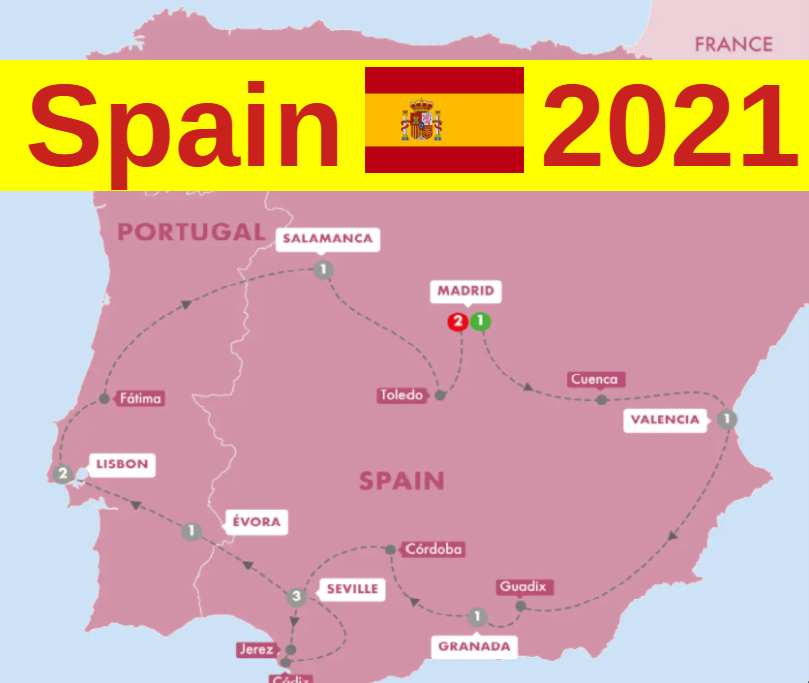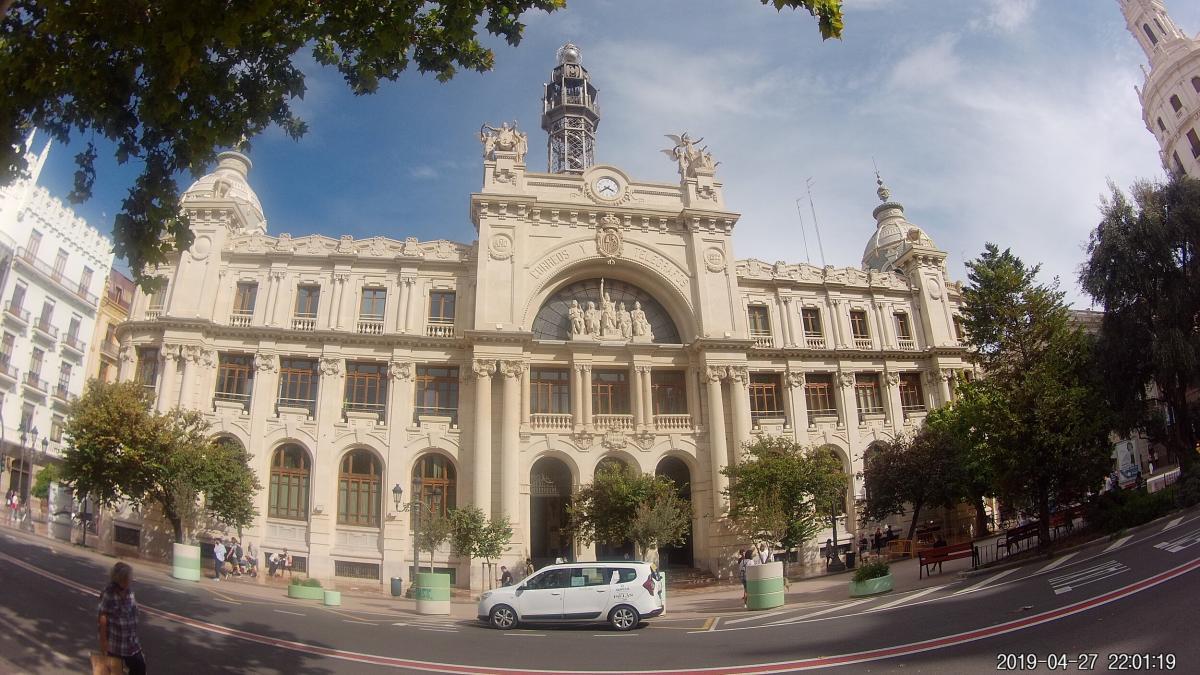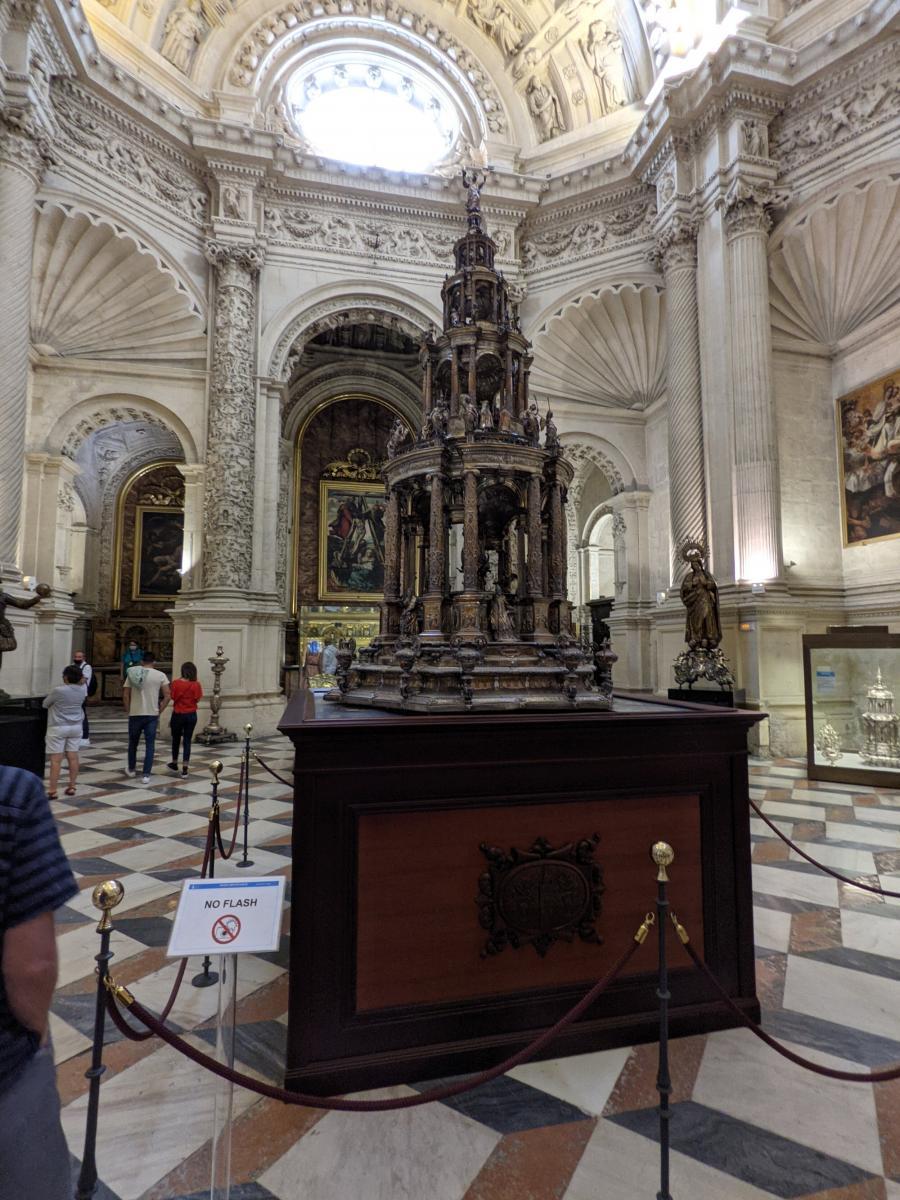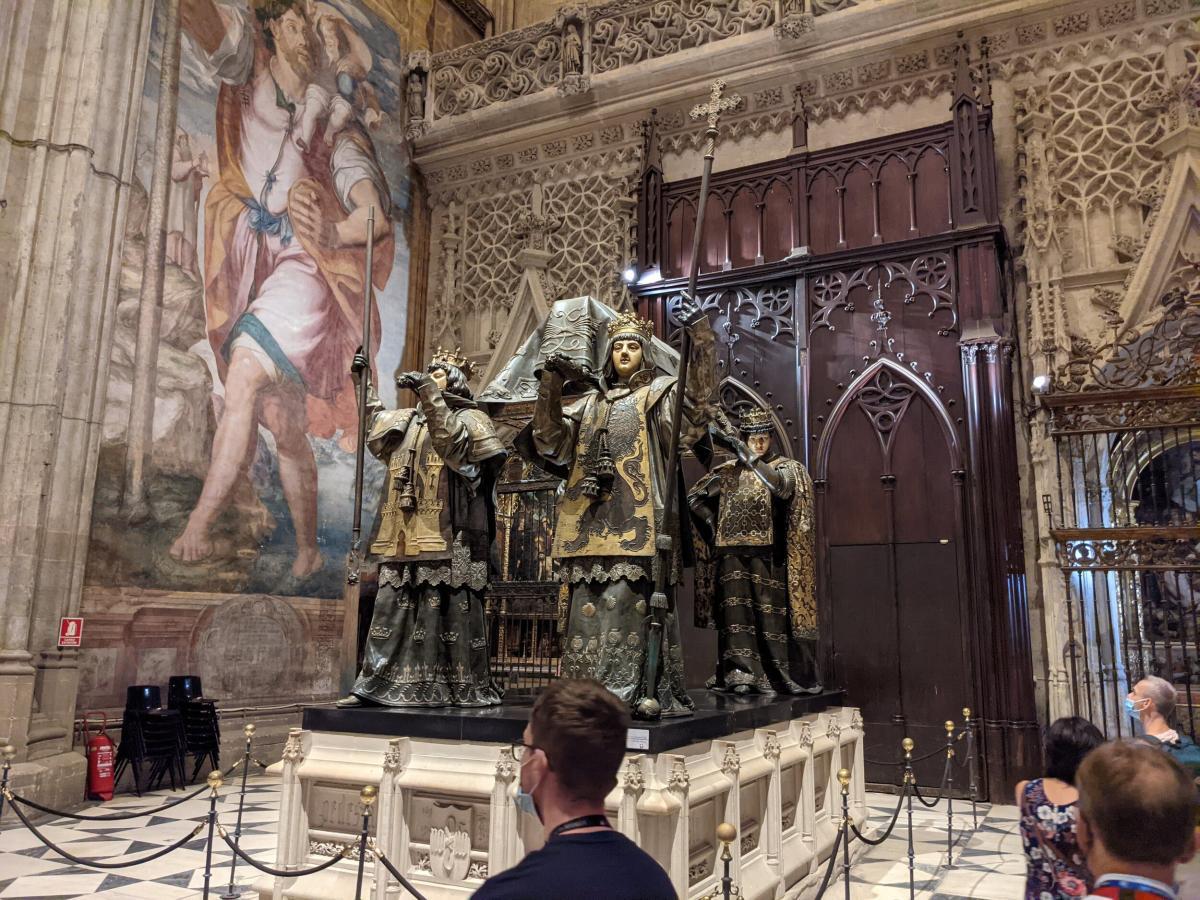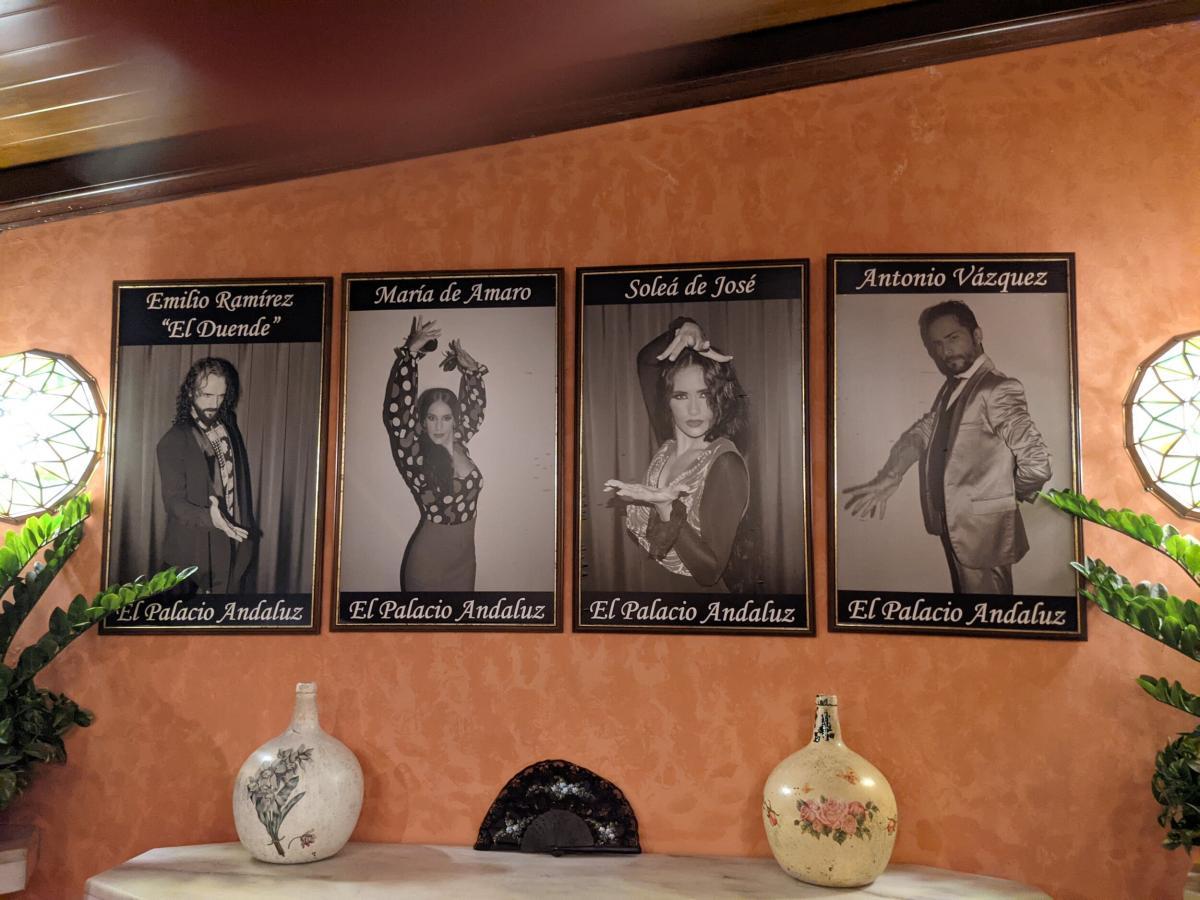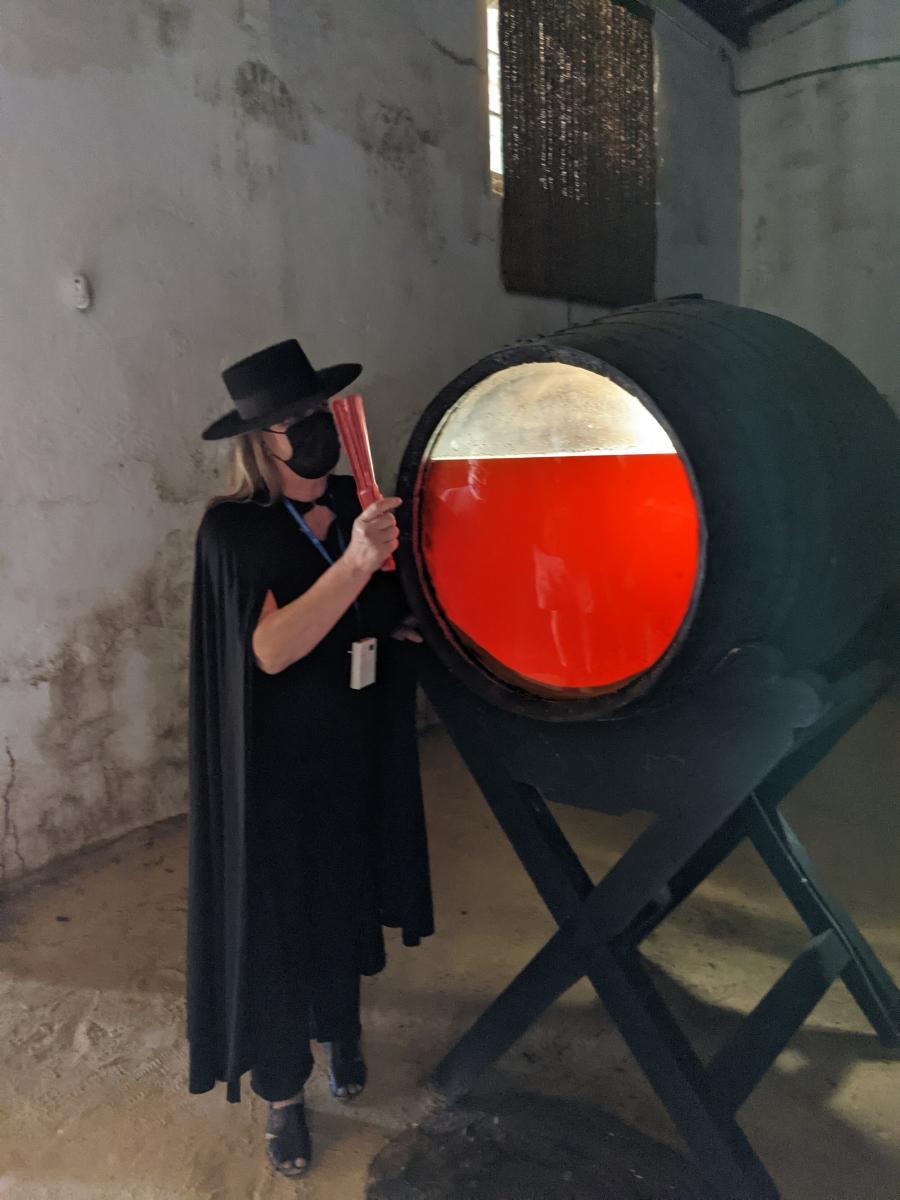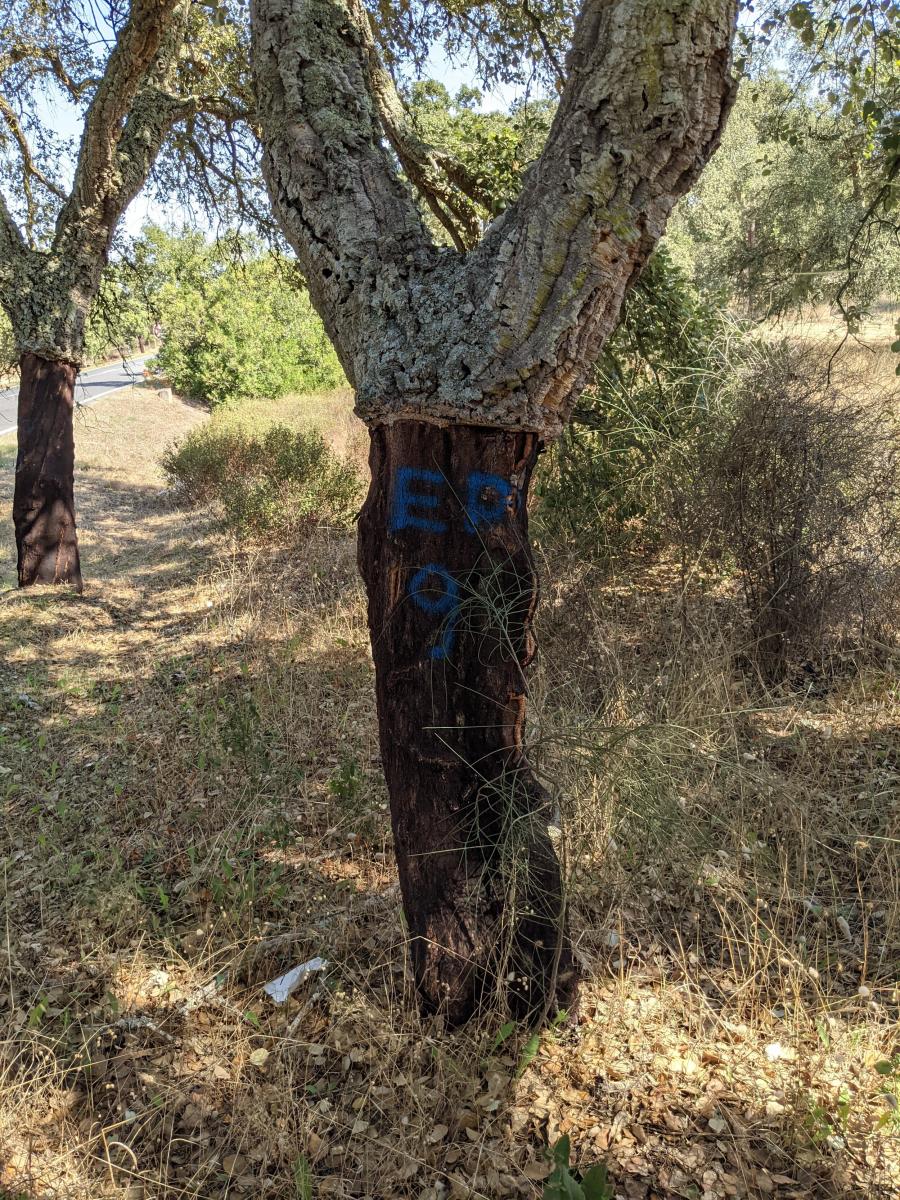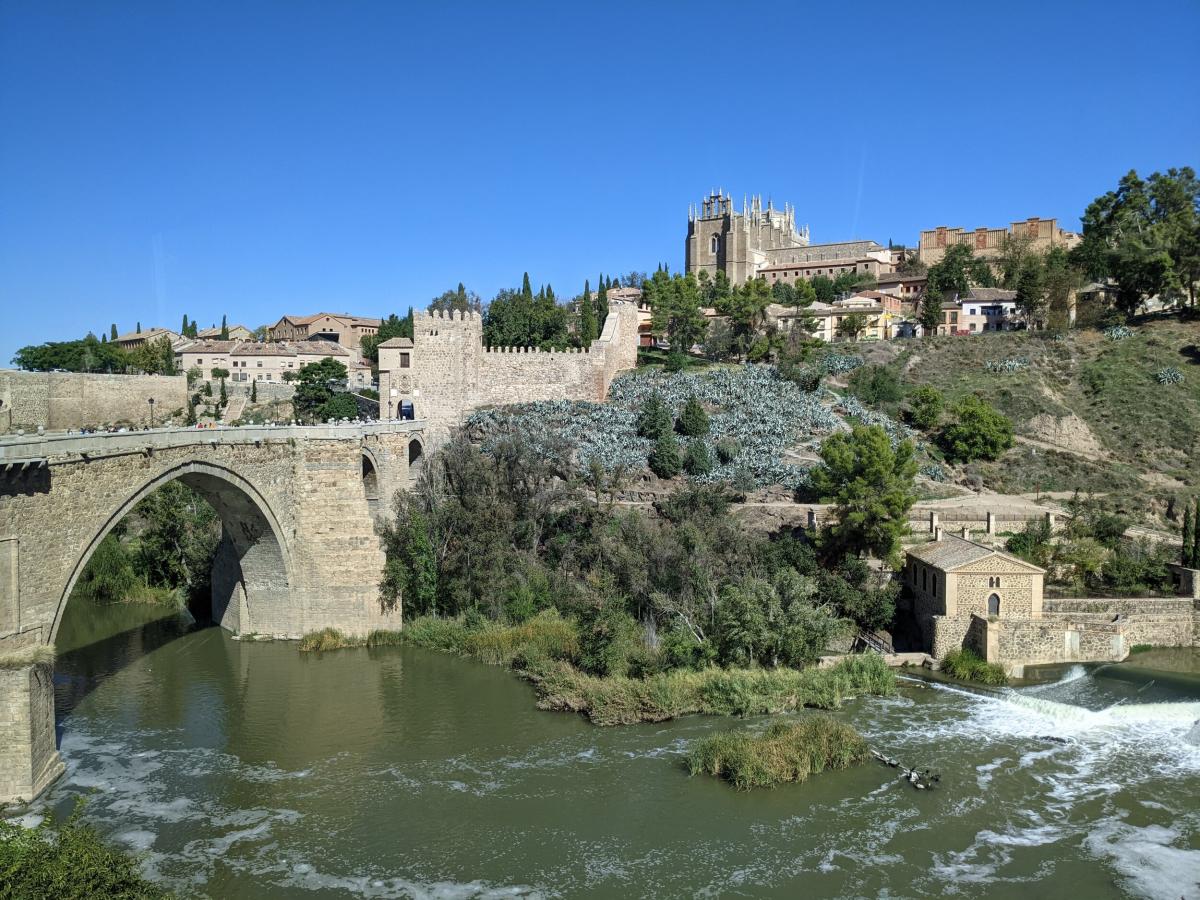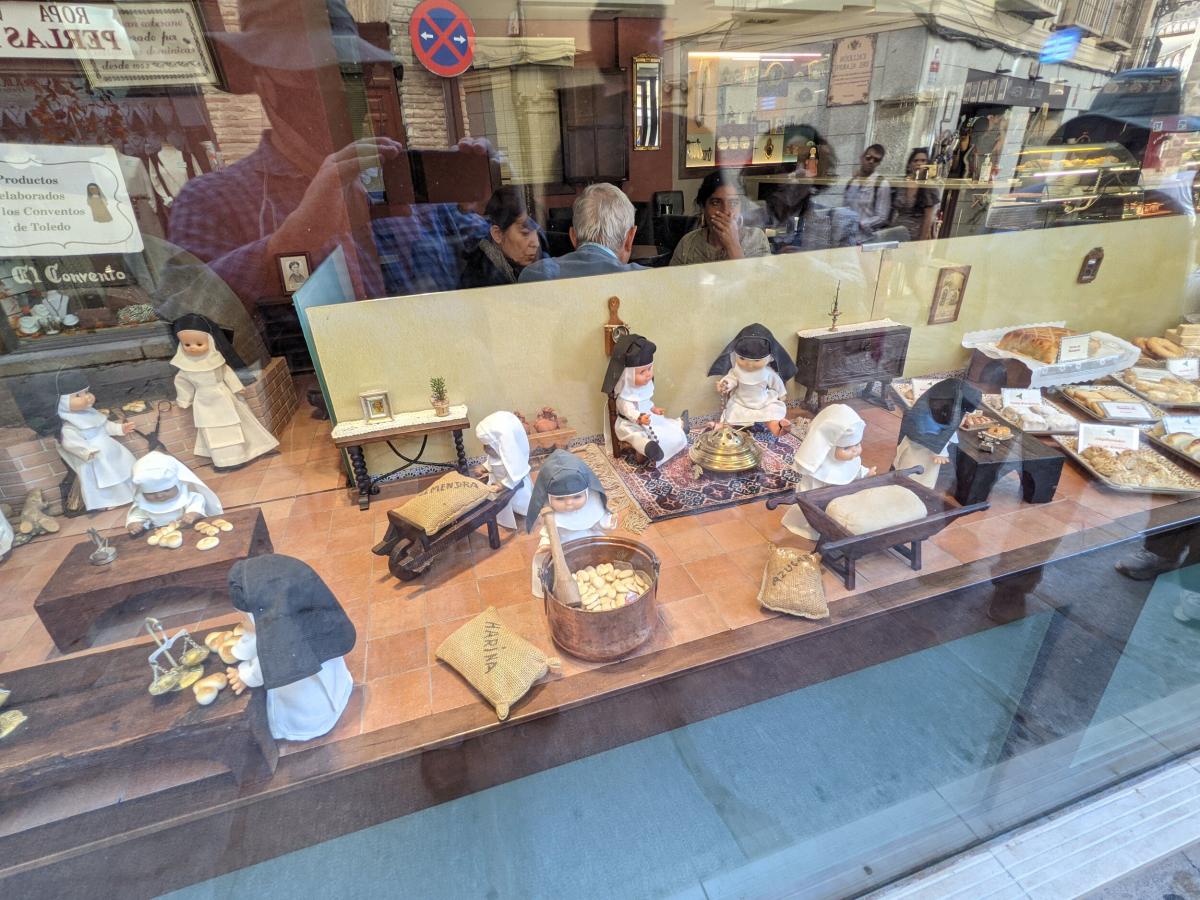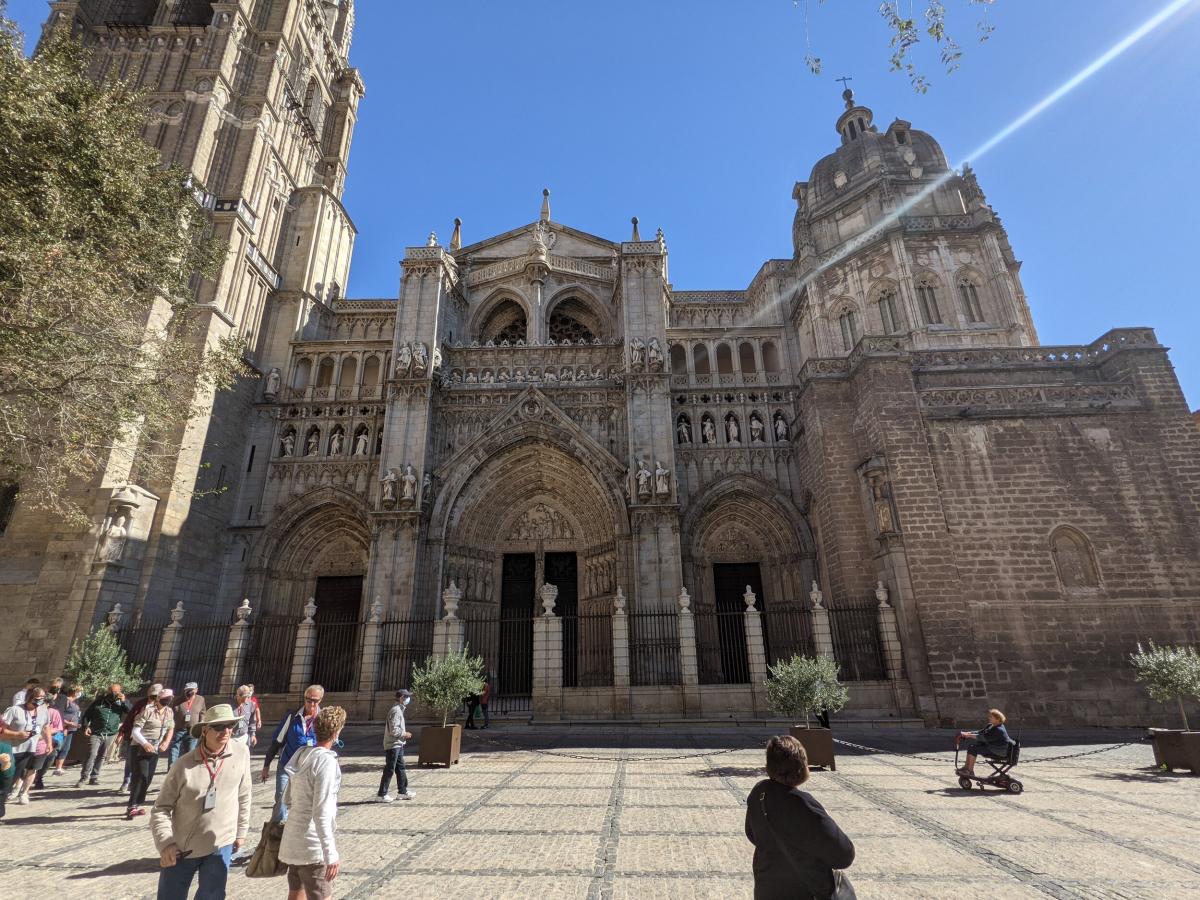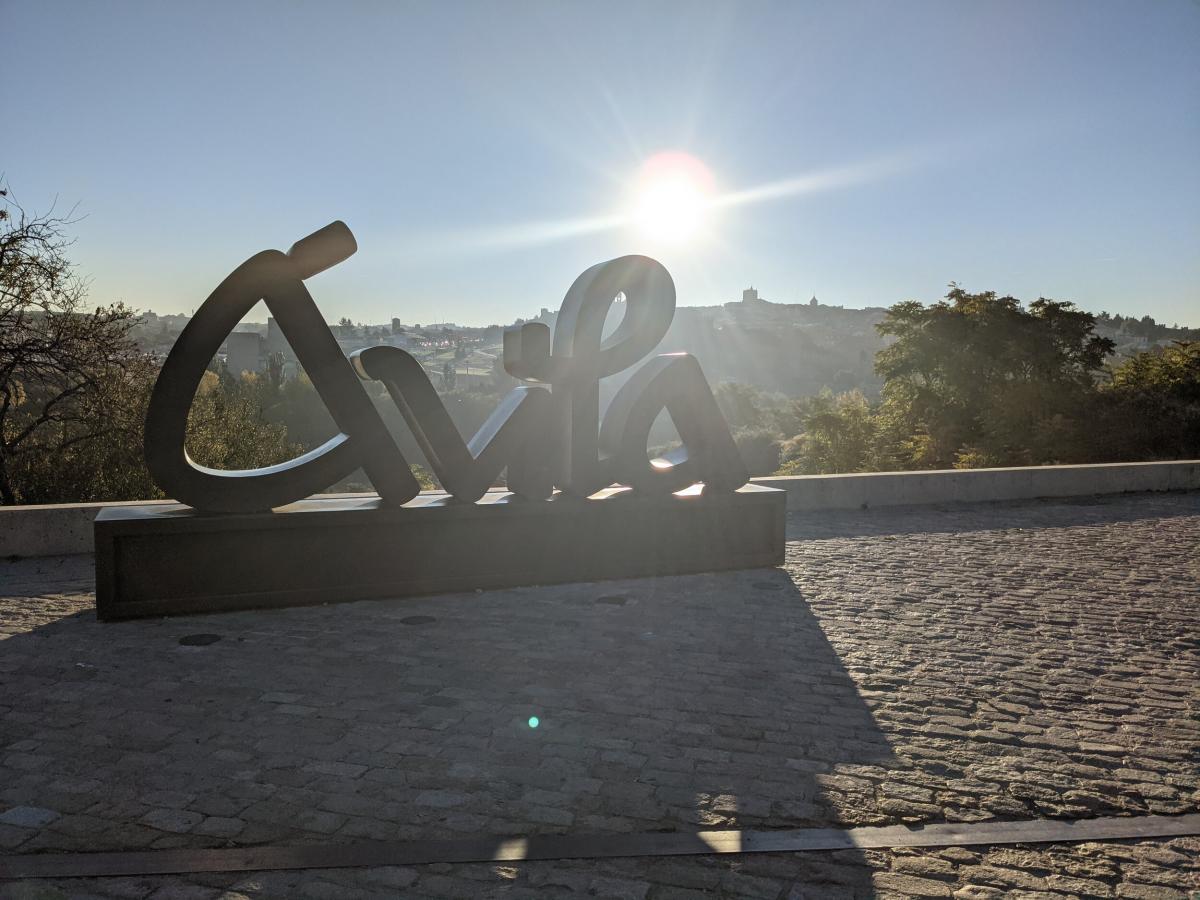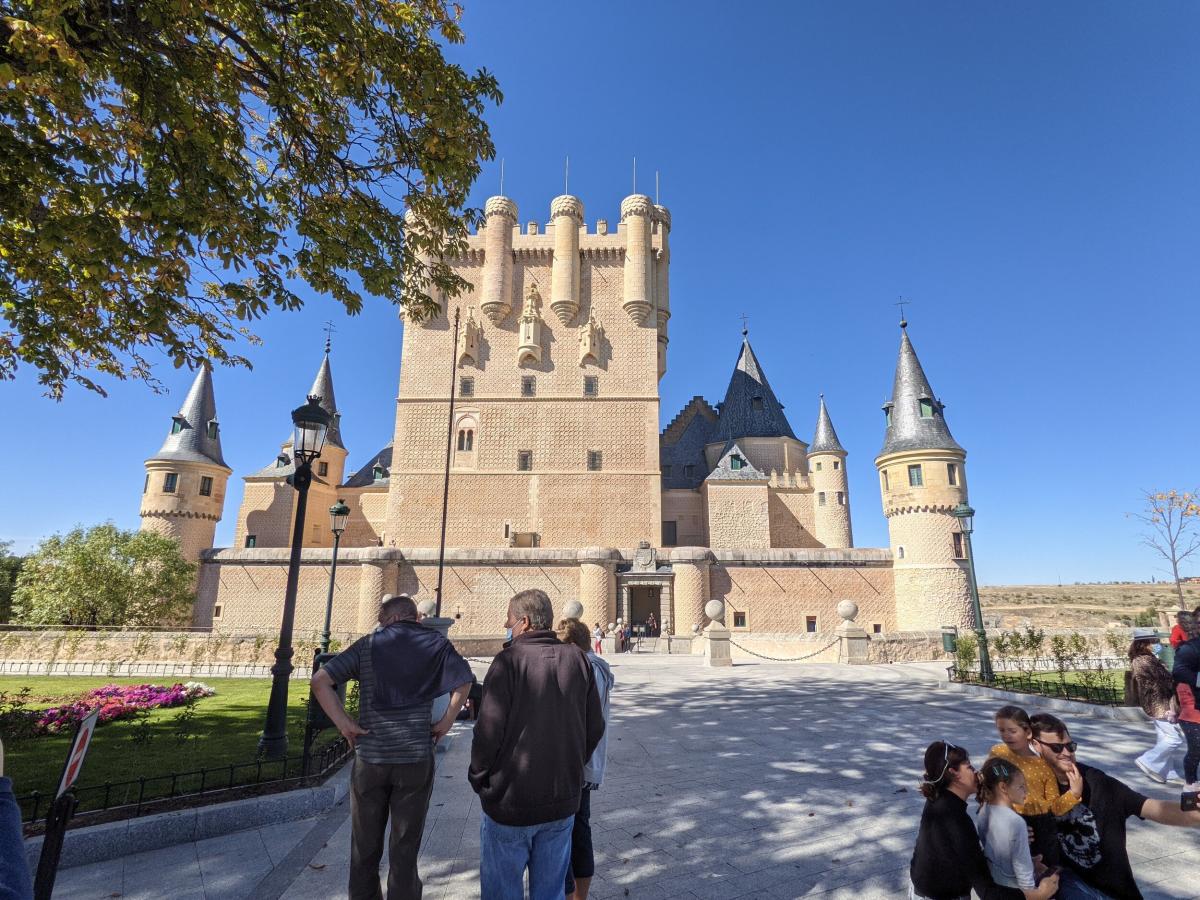

During the reception dinner, Alexandre told the tour group we would become good friends over the two weeks. He was right. Sharing our experiences with the such good people made the trip even better! We ate, we drank, we laughed, we sang, we danced, we walked and we talked our way through southern Iberia.
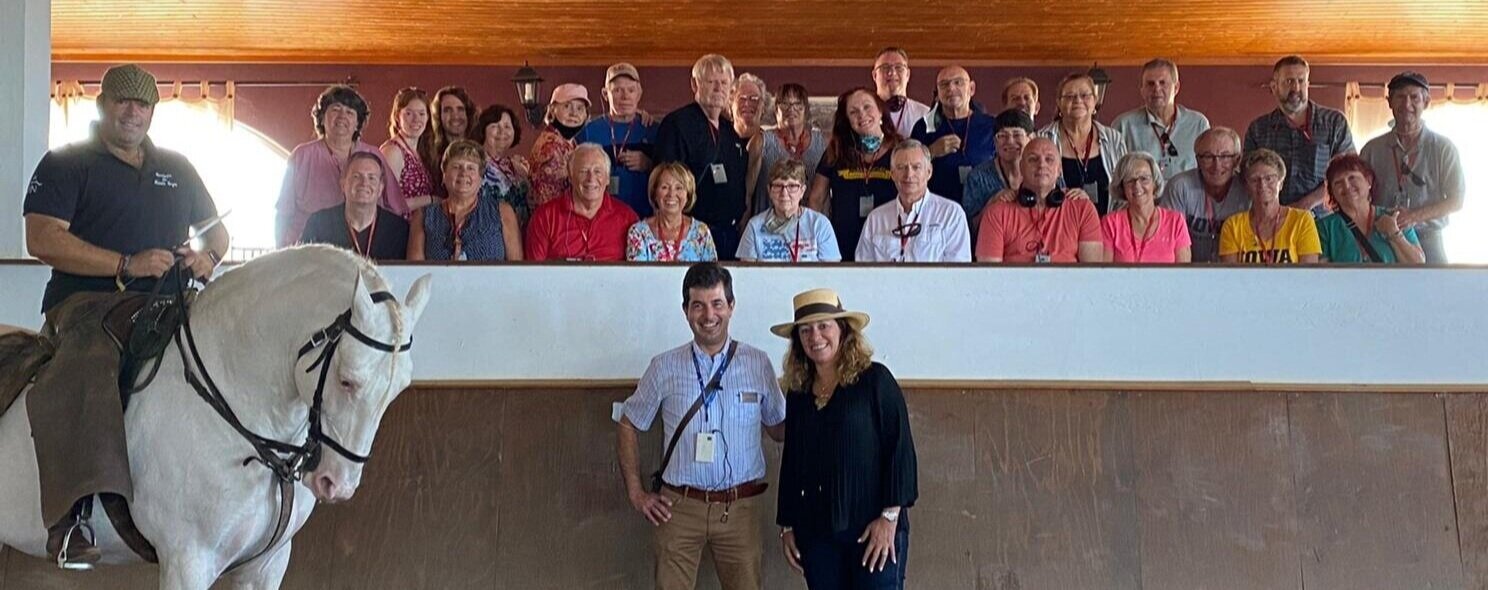
Day 1 – Madrid to Valencia
The first morning we boarded the bus before dawn, which comes late to Spain as its the western most country in the central EU time-zone. João drove southwest from Madrid towards Valencia, our first night’s stop.
On the way, we stopped at the town of Quenca, where we saw the “hanging” houses that protected the medieval town from the many invaders who made their way through the land. The morning stop also included coffee and pastries from a parador, a state sanctioned hotel preserving historic buildings. This parador was a former monastery atop the Huécar Gorge which protected the town on the other side.
Valencia
We entered the Mediterranean port city of Valencia and started with a bus tour of medieval and modern parts of the city. 14th century towers are just minutes away from modern architecture designed by Santiago Calatrava. We then had a lunch stop by Valencia’s market and finished the day with a lesson on making paella and a walking tour around the city’s cathedral.
Day 2 – Valencia to Granada
The second day on tour started the regular routine: Wake-up call at 6:15am, suitcases outside your door and breakfast at 7am and on the bus at 8am. Our first your stop was just outside the City of Gaudix, known for it’s troglodyte cave dwellings. Here, we went to a cave home and living museum belonging to Paco and his family. You knew this was the real deal when Paco had to break off his talk about building and living in cave homes to stop the cat from eating the lunch cooking on the stove.
The day ended up in the Sierra Nevada, the real, original Sierra Nevada mountains, in the city of Granada. It was here that Queen Isabela and King Ferdinand defeated the Moors and effectively unified their kingdoms into the country of Spain.
That evening we dined looking over the Alhambra, the last Islamic stronghold of the Iberian peninsula. We then watched the lights turn on the walls of the Alhambra as the sun set from a park full of gypsy music and hundreds of people.
Later, we walked through the gypsy Sacromonte quarter and watched their traditional Zambra dancing and singing. Zambra is a raw and primitive precursor to the better known Flamenco dancing.
Day 3 – Granada to Sevilla
The Alhambra
Wednesday morning started with a tour highlight, a guided walk through the Alhambra. Our guide, also named Paco, was a second generation in his family to provide tours of this World Heritage site. He was knowledgeable, articulate and very funny. He kept promising he would stop with his beat-box vocals, but I think he is still doing them. The Alhambra is a special place where so much happened in the numerous palaces, building and gardens. While many wars were fought here, even between Islamic factions, so were there hundreds years of peace where Islamic, Christian and Jewish people lived and prospered together.
There is no reference to the Alhambra as a residence of kings until the 13th century, although fortification has existed since the 9th century. The first kings of Granada, the Zirtians, had their castles and palaces in the hills of Albaicin, and nothing remains of them. The monarchs Ziries were in all probability the emirs who built the Alhambra, beginning in 1238.
The founder of the dynasty, Muhammed Al-Ahmar, began with the restoration of the old fort. His work was completed by his son Muhammed II, whose immediate successors continued the repairs. The construction of the palaces (called Casa Real Vieja) dates back to the 14th century and is the work of two great kings: Yusuf I and Muhammed V. The first is awarded, among others, the Fourth Comares, the Door of Justice , The Baths and some towers. His son, Muhammed V, completed the beautification of the palaces with the Hall of Lions, in addition to other rooms and fortifications.
The Alhambra became a Christian court in 1492 when the Catholic Monarchs conquered Granada. Later, several structures were built to house prominent citizens, military barracks, a Church and a Franciscan Monastery.
CÓRDOBA
Córdoba was founded at the foot of a Roman bridge, as was typical during that time. The Cathedral was originally a roman site, then a mosque and then a Catholic cathedral. The pillars of the mosque are mismatched Roman columns which were scattered/plundered by the Moors. Little is known of the Roman site as what is left lies under the cathedral. Fortunately, the Catholics decided to preserve the Moorish elements and adapt it to meet their needs. Our guide Gemma was true to her namesake, a real gem! Her passion for the cathedral and its history quickly became apparent when she hugged a column telling us what is had “seen” throughout history inside the mosque/church.
Day 4 – Sevilla
Day 4 was a tour of the main sights in Sevilla . This included the Plaza de America from the 1929 Exposition, the largest Gothic Cathedral in the world and the Alcazar. The evening ended with a night of Flamenco.
The Alcazar
Flamenco
Day 5 – Jerez and Cádiz
A day trip from Sevilla to Jerez de la Frontera and the ancient port city of Cádiz. The first stop was the Sandeman sherry bodega where we learned about the types if sherry and how they are made. Of course, in the name of education and research, we had to sample them at the end of the tour.
Then onto Cádiz, one of the longest continuously inhabited cities in Europe. The port city was known throughout the Roman Empire for its fermented fish sauce that was made here. I suppose if your used to rancid food, fermented fish sauce may actually sound appetizing. We opted for fresh seafood paella from the city market. As luck would have it, the Sail GP boats were in Cadiz this weekend for a round of their global season.
The day ended with a gluttony of Tapas back in Sevilla. The evening included guitar music where the “Macarena” may have been danced :). To work off the lotta tapas, we took a night stroll through the historic district.
Day 6 – Sevilla to Evora
Day six started early as we headed west across Andalucía to the Guadiana river into Alentejo Portugal. Our first stop was a Lusitano horse farm named Monte Negro. The farm has been in the same family for three hundred years. After learning about the farm’s history and the horses, we had a delicious lunch featuring home grown, home made ingredients.
After lunch, we boarded the bus and drove north to Evora. Evora featured a Roman temple, a gothic cathedral and the famous Chapel of Bones. We stayed inside the old city at a lovely hotel where we were served traditional Portuguese cuisine.
Day 7 – Evora to Lisbon
Leaving Evora, our first stop was Monsaraz, a medieval town atop a mountain. Then on to the capitol city of Lisbao. We walked the main square area, ate lunch and toured the river bank..
DAY 8 – SINTRA, ESTORIL, CASCAIS, LISBAO
The morning excursion to the west of Lisbao included a palace in Sintra, a drive through Estoril and the costal fishing port of Cascias. Then we went back to Lisbao for a local guided tour of the Jerónimos Monastery. Finally, a ferry ride across the Tigris River ended with a local seafood extravaganza dinner.
DAY 9 – LISBAO TO SALAMANCA
Day 9’s first stop was Fatima. We were fortunate to arrive just as a mass in the chapel located on the spot where Mary appeared to the three shepherds. We then rode through the countryside and onto Coimbra, Portugal. We then drove to Salamanca, Spain for a night walk and dinner.
DAY 10 – SALAMANCA, AVILA, TOLEDO, MADRID
Another early wakeup call, breakfast and on our way to a vista of the walled city of Avila. A surprise chocolate and churros morning snack was followed by a drive through the countryside of Castile La Mancha to Toledo. Then back to Madrid to complete the circle tour.
DAY 11 – MADRID AND SEGOVIA
The final day started with a bus tour of Madrid with a local specialist concluding with a walk around the Royal Palace. Then we drove north to Segovia to see the aqueduct and sites.
Remarkably, the tour guide told us there was nothing special about the Roman fort at Segovia. I bet the men who built the aqueduct would beg to differ.
Finally, back to Madrid for the farewell dinner.
